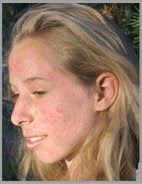How to Stop Acne
Post-acne Blemishes and Scars – Part 3
Copyright © Zion
Non-ablative Lasers
Newer laser technology allows the upper dermis to be selectively heated with resultant collagen remodeling, without damaging the epidermis (outer layer of skin). These newer lasers often incorporate a cooling device (cold spray or chilled tip) which first cools the epidermis before the laser is fired. This pre-cooling prevents the epidermis from damage, and significantly reduces patient downtime. The laser procedure can be safely performed with normal or no anesthesia and carries the risk of few complications. Several treatments are needed (usually 4-6), at 4-8 weeks intervals. The results of non-ablative laser treatment are gradual; the patient may see 15-20% improvement. The effects on shallower acne scars are better than on deeper ones.
Chemical Peeling
Repeated superficial chemical peeling, for example with glycolic acid, may mildly improve shallow acne scars by stimulating gradual remodeling of the collagen fibers in the upper dermis. Additional benefits include improvement in surface texture and fewer blackheads. Unfortunately, deep scars do not improve much with chemical peeling. Superficial chemical peeling should be performed by an experienced dermatologist to avoid complications, such as chemical burns to the skin.
How to Stop Acne
Filler Injections
Filler substances can be injected directly into the dermis below the scar, to elevate it for rapid, albeit temporary, improvement. Most fillers generally last about four to six months before absorption by the body. This technique can be considered for box-car type scars and rolling scars, especially if there are only a few isolated scars.
Dermabrasion
This technique, using a medical-grade sending device to manually remove the surface skin up to the upper dermis has largely been replaced by laser resurfacing as manual dermabrasion is a bloody procedure and is highly dependent on the skill and judgement of the doctor performing the procedure.
Hypertrophic and Keloidal Acne Scars
These are the thickened, cord-like scars resulting from excessive formation of scar tissue following active acne. Such scars appear more frequently in the Negroid race, and in individuals with a past history of keloids following skin injury. Hypertrophic and keloidal scars are also more common over the jaw line, anterior chest and shoulder regions. Treatment is difficult – partial flattening of the thickened scars can be achieved by techniques such as liquid nitrogen cryotherapy and careful injections of steroids into the scar by an experienced dermatologist. Over-the-counter scar cream and silicone gel sheeting are usually ineffective.
Hypertrophic and keloidal acne scars can be partially flattened with liquid nitrogen cryotherapy and steroids injections.
How to Stop Acne
Friday, October 24, 2008
Subscribe to:
Posts (Atom)




